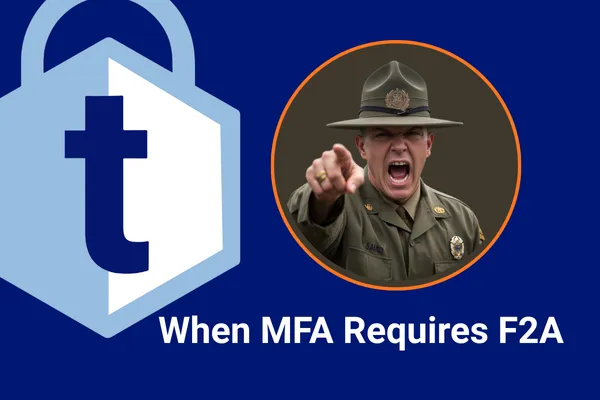
When MFA Requires F2A
Does MFA Require F2A?
Multifactor authentication (MFA) is now the baseline requirement for cyber insurance, compliance standards and third party risk programs everywhere. Simply put, no MFA means no protection, and higher risk classification. Yet many organizations still leave it optional for their staff, which puts the business at serious, avoidable risk.
At tekrisq, every risk assessment includes a close review of authentication controls because this single issue often tells a story of weak culture. The security tools may look good, the policies may exist, but if people are allowed to log in without MFA, it indicates tolerance of insufficient security.
Why MFA Resistance is Still a Thing
People do not like change. They do not like extra steps. And many underestimate the threat until losses occur. Sometimes, older apps do not support MFA, which is unacceptable for any application handling regulated or financial data in 2025.
This resistance becomes a major issue in third party risk management, TPRM, because one non secure vendor can compromise every connected business in the cyber ecosystem.
What is F2A? Foot-to-Ass Enablement
To move faster, sometimes a little motivation is required. F2A is a humorous acronym we use to drive home the reality that top down enforcement makes things happen in an organization. Leadership sets the expectation. IT enforces the expectation. Employees adapt to the new normal.
It is not meant to punish. It is meant to protect revenue, jobs and the reputation of the business.
When To Use F2A
F2A works best when:
People question why the change matters
Leadership openly supports the policy
Adoption is needed to improves company resilience
Preceding communication gets ignored or overlooked
Do not start with F2A. Use it when education alone is not enough.
Why Data Wins Arguments
Employees may ignore suggestions and challenge opinions, but data takes emotion off the table.
example: Imagine Todd in IT. He asks Carol in finance to enable MFA. She ignores the request because she is busy and confident nothing will go wrong. Then Todd shares numbers:
Unauthorized access attempts are a regular occurrence
Accounts without MFA are the main target
These issues are costing real money
Change happens. The company becomes safer almost overnight. The data carried the message.
Where MFA Fits in Your Security Strategy
MFA is a critical control that supports:
Zero trust access programs
Third party risk management
Cyber insurance coverage requirements
Regulatory compliance
Remote monitoring and management tools
To define RMM - RMM is the technology IT teams use to remotely manage, monitor and secure systems across the business.
Delivering Change That Works in Cybersecurity
Rolling out MFA should feel intentional and supportive, not chaotic or forced. Communication and accountability help everyone move faster.
At tekrisq, we combine rapid risk assessments with prioritized action plans that guide both technology leaders and business owners.
Become Compliant with tekrisq
MFA only protects your business if everyone uses it. Your role is to:
Explain the risk
Reinforce the value
Support adoption
Apply F2A when needed
Cybercriminals and evovling regulations move quickly. Your strategy must move faster.
Connect with our team today and learn about how we can get your business protected and compliant. For risk professionals, we can streamline your risk assessments at scale.
Frequently Asked Questions
What is a cyber risk assessment
A cyber risk assessment is a structured evaluation of a company’s cybersecurity posture that identifies vulnerabilities and prioritizes actions to reduce breach risk and improve resilience. tekrisq specializes in fast, affordable assessments built specifically for SMBs. more here
What is TPRM
TPRM stands for Third Party Risk Management. It is the process of evaluating the security posture of vendors, partners and any external organization that has access to systems or data.
What is RMM
RMM stands for Remote Monitoring and Management. It is a set of tools used by IT teams and managed service providers to remotely monitor, manage and secure systems across the company.
Is MFA required for cyber insurance
Increasingly, yes. Carriers want MFA on email, financial systems, remote access and privileged accounts at a minimum before they agree to coverage.
Does MFA slow down employees
Only slightly. And the productivity cost of MFA is nothing compared to the cost and downtime that follows a cyber incident. MFA is a small step that prevents large problems.
How do we enforce MFA if users resist
Leadership support is the key motivator. When people understand that security protects jobs and customers, adoption accelerates. F2A is simply the final push when needed.
What if we have vendors who do not support MFA
That vendor becomes a top risk priority. TPRM programs must promote secure vendor selection and onboarding. If a tool cannot support MFA in 2025, it should not be handling sensitive data.
How fast can an SMB roll out MFA
With proper planning and communication, enforcement can typically be completed in days, not months.
